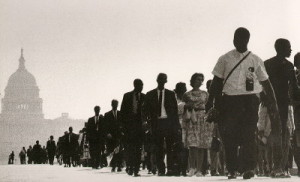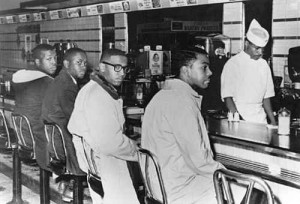The civil rights movement is filled with so many great stories, and it’s perhaps one of the few things we can be certain our students have some basic understanding of: it’s got to be easy to teach, right? And yet, and yet…every time I finish my lecture on the subject I feel I’ve let my students down.
Before I know it, it has turned into a litany of one damned thing after another. How boring!
It starts off well. I try to convince them that any notion of there being a single “civil rights movement” is highly questionable, and that they are better served by thinking of at least two civil rights movements (at the least), one about ending segregation in the South (that’s the story they know from high school), the second about advancing racially defined economic, residential, professional, and social equality (that’s the one they know from their daily lives, even if they don’t think of it in historical context yet). Getting them to look at civil rights that way forces them to recognize that the narrative from 1954 to 1965 doesn’t get at nearly all the momentous challenges of the color line in American life. The civil rights movement as they have thought of it just gets at a small part of it.
It continues strong too, I think. I then tell the inspiring story of the Greensboro Four. Not only is it a great story, but also the key players are four college freshmen who cobbled together their plan in their dorm room after being snubbed upon returning from winter break. Hey students in those bolted down seats, don’t think you have a role to play in history? Neither did they.
But after that, I’m not happy with the lecture. I recap civil rights to the 60s, then plod along with the story. One damned thing after another.
My plan next time is perhaps something like this: teach the civil rights movement in three (or four) stories. Let the students get the narrative from HIST; let me tell great stories. My students are very interested in the Greensboro Four. What if I just tell the story of Linda Brown (Brown v. Board), of Rosa Parks, of the Greensboro Four, and of the March on Washington, the Civil Rights Act of 1964, and then the Watts Riots? Four big stories they can sink their teeth into (and remember!) and less plodding along.
Uncovered here I come!
Can anyone out there help with suggestion from their own experience, as a teacher or student? What’s worked for you?





Having learned some of civil rights back in high school, the idea of using stories over straight legislative accomplishments will keep students more engaged. As the Greensboro Four story kept our class engaged, I was hoping for more. While the article “The Supreme Court Rules on Brown v. Board of Education, 1954” tells us about the outcome of the ruling desegregating public facilities, it does not tell us of the story that Linda Brown went through to get the Supreme Court to listen to her. Similarly “Reverend Martin Luther King, Jr., Defends Seamstress Rosa Parks, 1955” tells us of MLK’s reaction to the incident that Rosa Parks was “carried to jail and arrested because she refused to get up to give her seat to a white person”, it does not give us the aftermath of the story that is wanted. As San Diego is so close to Los Angeles, the Watts Riots would be a great story to discuss. The geographic proximity makes it exciting alone as well as Watts has continued to be a black ghetto in Los Angeles. I would agree that using stories is the best way to capture the civil rights movement. Let us read from HIST to get the cut and dry legislature of the era. (Furthermore, it gives more motivation to come to class to hear stories that are both interesting and relevant but cannot be found in either book)
I believe that the Civil Rights Movement helped push America forward and embrace different thought and opinions. Prior to this, Americans were subconsciously taught that conformity was equal to democracy. Millions moved to the suburbs where every house looked the same. Even religion became a victim of conformity with the unification of three religions: Protestantism, Catholicism, and Judaism. I feel that the Civil Rights Movement opened American’s eyes to the fact that conformity was not working. This was made more prominent with the 1965 Immigration Act. That act brought new immigrants who brought with them their religious beliefs.